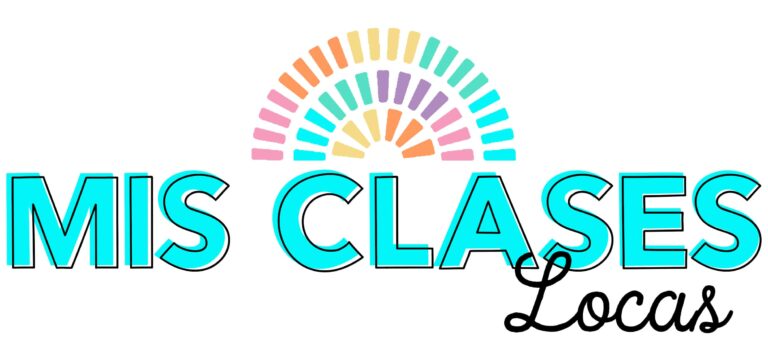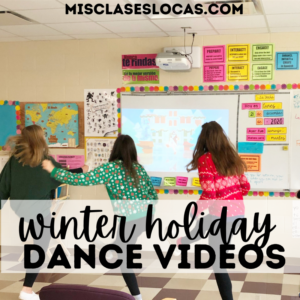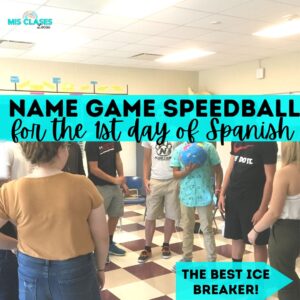Inside: 15 ways to get your Spanish class moving with engaging games & Spanish class activities. Movement activities for Spanish class.
By – Allison Wienhold
Most recently updated 12.19.24. Originally posted on Mis Clases Locas 3.28.17
Getting Spanish class moving has always been a passion of mine. I originally published this blog post during my 1st school year Deskless.
Since then I have presented my session “I Like to Move It (Move it)” at half a dozen conferences. This award-winning session has been presented both in person and online. My session about getting World Language classes moving won best of IWLA in 2018. I presented it as a guest speaker in Texas at TFLA in 2019. I also presented the session as the invited Best of Iowa at the Central States conference in 2020. (Yes, right before the conference & then the world shut down).
If you are interested in having me present this or any other session at your school or organization, please reach out via the contact form and learn more here. >> Professional Development
The original blog post had 10 ways to get your classes moving. It has now been updated with 15 ways to get your Spanish classes moving with modern modifications and links.

15 Ways to Get Your Spanish Class Moving
Once I switched to a deskless classroom in 2016 there was so much room for activities! I have seen so many articles about how important it is for students to move during the school day. Getting students up and moving is essential for all of those pent-up wiggles.
I started asking myself, how could students move while doing this activity? For example, for discussion questions. Instead of sitting and discussing questions, cut them up and post questions around the room. Have students float from question to question asking and answering in pairs.
Here are some of my favorite ways to incorporate movement in Spanish class.
Movement in Spanish Class Idea #1 – Dance

Way back in 2014 my class and I coined the term baile viernes to refer to starting class on Friday with a dance in Spanish. (Yes, I know it is incorrect, but the name stuck).
I play a Just Dance or Zumba video in Spanish from my giant YouTube playlist. The dance is projected on my screen during passing time.
If the class is into it, we may do one more dance when the bell rings and everyone is there. The whole thing takes 3 minutes of class and gets out the Friday wiggles. Besides just baile viernes, here are 5 ways to use dance in any class.
If you want to take the work out of finding dances for Spanish class, I have you covered!
- Ready to go Google Slides with dance – NEW Baile viernes 2025 Spanish Brain Breaks
- Ultimate list of Just Dance in Spanish Class
- Spanish Just Dance partners songs – great for Valentine’s Day
- Holiday dance videos – baile viernes navidad
- Halloween dance videos for any class
Speedball

A great way to start with a new group of students is to play name game speed ball. You have students toss a ball while asking each other their names in Spanish. I have a Name Game Speedball Slides Freebie below in Spanish & French if you want to try it out.
Speedball could be adapted for any question in Spanish. To make it “speedball” have students make a certain order, which includes everyone. Then let a student time to see how fast they can be completing the order, while also being accurate. This works great as a brain break as well. Anytime students get to toss a ball, they are in heaven.
1,2,3 Salta! Quick Movement Game for Spanish Class

A newer addition to this list is 1, 2, 3, ¡SALTA!. I learned this game from a Srta. Spanish unit. It is a quick fun review game that gets students moving. All you need is a list of True & False statements in the target language about a text your students are familiar with. (If you are prepared they can be in a slideshow you click through one by one, or you can just read or come up with them on the fly).
How to play the Spanish Game 1, 2, 3 ¡SALTA!
- First, have students line up in the middle of the classroom or space (move desks or tables if needed, or move to the hallway, common space, or outside).
- Then, let students know which side of the space is true & which is false.
- After reading a statement in the target language, say 1, 2, 3, ¡SALTA!
- After hearing Salta, all students jump to the true or false side.
- Then. discuss the statement that is needed and circle the correct statement.
- Finally, all students return to the centerline.
- Then, repeat with about 10 statements.
Learn more about ways to mix up fun activities in the classroom in the blog post 1, 2, 3, ¡SALTA! (1,2,3 Jump!)
Find Someone Who – longer movement activity

A great interpersonal activity that allows a lot of movement is a find someone who. Many names and versions of these activities can be found online for your specific unit or goals.
It works nicely to have all questions focusing on the same target phrase such as “do you like…” with options for others to sign. I always tell students that they must ask and answer the question out loud in Spanish to be able to sign someone another sheet. It is a nice way to get in a lot of repetitions of the informal you and I forms.
To extend a Find Someone Who you can have students then use the s/he or we form to write or talk about what they found out about their classmates. I have ready-made weekend activities find someone who, I can pull out as an easy Monday activity to practice the past tense.
- 1st Day of Spanish 2 Find Someone Who
- 1st day of Spanish Mi Verano Find Someone Who (great for Spanish 3+ Day 1)
- Free Spanish 1 Tener Find Someone Who
- Find Someone Who Spanish Bundle
- French Weekend Chat FSW
Quizlet Live Relay Race – Quick Movement Activity

Quizlet Live is a great time filler with an extra 10-15 minutes at the end of Spanish class. I rarely create anything myself and search the chapter of the novel we are reading or unit of study and find either vocabulary or questions in Spanish. But to keep it fresh and also get students up and moving I love the variation of Quizlet Live Relay Race.
How to play Quizlet Live Relay? Students all join Quizlet Live like normal with a projected code. I recommend using school computers if you have them. This activity involved students using each other’s devices, so it does not work well with personal electronics.
Students set up all computers on a table and then stand on the other side of the table. Or they can be far back from the table if you have enough space.
One member at a time runs up to the computers to answer the question for the whole group. Like a relay race, once they return the next team member has a chance to answer the next question. This repeats until everyone is done. You can see more details in this Quizlet Live Relay post.
Question Cards Around the Room

Question Cards are very versatile and once you have some printed, you can break them out to mix things up all of the time. If you need to work on asking and answering questions for any topic, try question cards around the room.
Tape up the questions around the school, outside, in a common area, or just in your room. Then have students move around in pairs taking turns asking and answering. It beats just writing down answers in a notebook and gets students moving and engaged. They are super easy to start a class for Weekend Chat too.
If you want ready-to-go question cards, check out my Spanish Conversation Cards Bundle.
Running Dictation – Full Class Movement Activity

I learned about Running Dictation through Martina Bex’s curriculum (before it was even called Somos). It is a great Friday activity that gets everyone moving to review a class story or chapter of a novel. I used this activity during an observation as a review of chapter 3 of the novel Brandon Brown Quiere un Perro. It went great and my administrator was impressed with how everyone was actively engaged.
All you need for Running Dictation are 8-10 sentences typed up in a large font in Spanish. These sentences should not be new to students, but rather from a book chapter or story. These can be taped up all around a room, or better yet in a hallway large common area, or gym.
There are many variations to the activity, but here is what I do. Students are broken into teams of 3-4 students and the “jobs” rotate after each turn. The jobs are as follows:
- Runner – Goes to read the information and verbally recites it to the writer. They may need to take multiple trips to fully relay the information.
- Writer – Writes down what the runner says
- Artist – Draws what the writer wrote (to show comprehension)
- Editor/Cheerleader – an optional job for those who have 4 members
In my classes, students write each sentence and draw on a 1/4 sheet of scratch paper. Then they put them in order as well as an extension. I know other teachers have a specific sheet to record everything on or have many other ways to mix up this activity. You can learn more here.

What’s My Answer Spanish Class Game

The idea for this activity came from the teacher’s guide of the book Fiesta Fatal. You can see the full game description here.
In short teams of students, all have the answers to a set of questions the teacher reads. Each student has a few of the answers on small cards and listens for the corresponding question to be read. When they hear their question, they run with the correct card to race to be the first one to slap their card on the front table. This could be done to mix up a variety of boring comprehension questions while getting students up as well.
4 Corners with a Twist

Anytime you have four characters or four ways to feel about something that can be posted in the corners of your room, you can do 4 Corners. Just make simple signs to post in each corner of the room.
The teacher reads a statement and the students move to the corner that best matches it. So if they are who said it quotes, you move to the character that the quote applied to. It could also be four emotions posted. Or post I like, I like a lot, I do not like, I do not like a lot to practice the phrase me gusta.
If you want to mix it up, you can bring in 4 Corners with a twist. Read the post for all of the info. It is another no-prep way to get antsy students up and active during what otherwise would just be a seated discussion.
This can also be simplified with just two options standing up and moving to each side of the room for true/false statements or yes/no personal questions. See below for a twist with 2 options.
World Language Class Brain Breaks

An easy way to incorporate movement in Spanish class is to schedule brain breaks. In my 50-minute classes, I like to do one about midway through class. But, if you have a longer block schedule, you may want multiple.
By definition, a brain break is a 1-2 minute break for your brain, which for me always includes movement. This can be as easy as doing some TPR gestures in Spanish or a team-building activity like a human knot. You can always play a dance video, or teach students an old-school hand-clapping game in Spanish like Chocolate. You can see a whole collection of brain-break ideas here.
It works best for me to have instructions for a brain break already pre-planned in my slideshow to help get it short and sweet. If it is not written in the agenda, I find myself skipping the break in favor of more content, which is the complete opposite of the whole point! Not only is it great for the students, but the teacher to reset as well.
Get Off The Bus (What do you like more game)
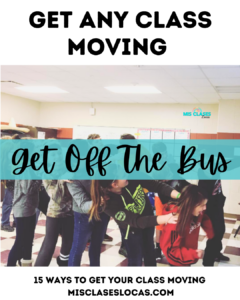
I learned the game Get off The Bus from Camp Adventure. If you did not know I was a camp counselor around the world for many years! Like many camp games, this works great in the classroom.
Everyone starts in the middle of the classroom “on the bus.” To make this more entertaining, have students pretend to be on a bumpy bus ride with a driver in front leaning side to side.
Two options are given, which I project side by side. Everyone must “get off the bus” or choose a side. Below you can see how novice students practiced talking about what we liked more.
You could also do this activity with true/false, possible/probable, or intermediate students taking sides on debated issues.
Once they pick a side, you could have a representative tell them why they made their choice. Then get back on the bus and repeat. If you have more than two options you could turn it into 4 corners instead.
Positive Plates
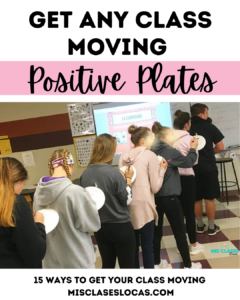
This is another team-building activity that I did as a camp counselor but brought to my Spanish classroom.
For Positive Plates, each student gets a paper plate or piece of card stock taped to their back. All students walk around with a pen or small marker and write positive things about each other in Spanish.
It is a great morale booster and I had students put these in their lockers or hang them up at home to look at when they are having a bad day. You can read all about setting up this positive activity here. Plus here are more Paper Plate Activities for Class.
Reader’s Theater

While reading a class novel Reader’s Theater is a great way to get students up and moving. It also provides a visual input to the rest of the class.
Select a portion of the text that has good conversation and have students act this out. To mix it up sometimes I have all students in groups prepare, and then let a couple of volunteer groups act it out.
Another twist is to have “silent actors.” I play the audio recording of a book chapter, and students get to dramatically act out with props, without actually having to speak. This is great for novice students, to make sure that everyone is getting the correct pronunciation and it is much less stressful for the actors. Above you can see silent actors for chapter 5 of the novel Tumba.
Cardboard Gloves
If you are doing a unit about sports, the novel Felipe Alou &/or the film Pelotero the activity Cardboard Gloves is perfect. You have students create cardboard baseball gloves and try to play a game. My students even brought in a nice stick they found at track practice to use as our bat.

Brain Bursts – Mini Movement Break
If you do not have time for a full brain break, try a brain burst. La Maestra Loca coined this term as a quick twist on a brain break. Brain bursts are rapid-fire and only last 1-5 SECONDS. She shares a huge list of them here.
In my deskless room, this can be as easy as standing up if you are wearing red and switching places. Or stand up, do three jumping jacks, and sit down. It could also be a couple of quick TPR moves. This is all done in Spanish and gets everyone to wake up and refocus.
Children’s Songs for Spanish Class Movement

Authentic children’s songs in Spanish are a perfect and natural way to get students moving around. Teach the motions to songs like Los Pollitos Dicen or Head, Shoulders, Knees & Toes in Spanish and then use them throughout the year. These are the songs students will be singing for years to come!
What other activities do you use to get your class moving? Please share in the comments!
